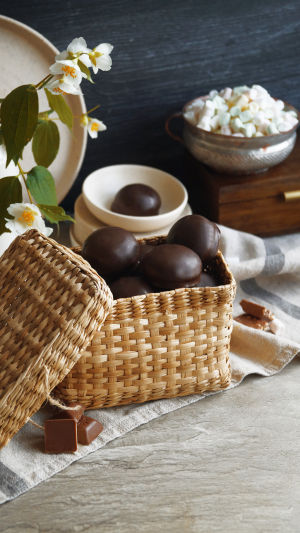The tale of chocolate stretches back millennia, with its roots deep in the rainforests of Central and South America.
The ancient Mayan civilization was among the first to cultivate cacao, recognizing its unique properties.
Unlike the sweet chocolate treats we know today, the Mayans would grind the cacao beans into a paste and blend them with water, spices, and chili peppers to make a frothy, bitter drink called "xocolatl," which means "bitter water."
This drink was cherished for its energizing and invigorating effects, playing an important role in their culture.
Following the Mayans, the Aztecs adopted cacao into their daily lives and even considered it a highly valuable commodity. They didn't only consume cacao; they also used it as a form of currency. Cacao beans became so essential to the Aztec economy that they were exchanged for various goods and services. Aztec royalty, including the famous ruler Montezuma, was known to drink large quantities of this cacao beverage, emphasizing its status and power.
<h3>Chocolate's Arrival in Europe</h3>
When Spanish explorers arrived in the Americas in the 16th century, they were introduced to cacao, which soon made its way back to Europe. At first, Europeans were unfamiliar with the bitter taste of cacao, but they quickly began to modify the recipe by sweetening the drink with sugar and adding spices like cinnamon. The drink gained immense popularity among the European elite, who cherished it as a luxurious treat.
By the mid-17th century, specialized chocolate shops became fashionable in cities across Europe. These establishments, much like modern cafés, became trendy gathering spots for the upper class. The rich, decadent nature of the drink made it a sought-after indulgence, and enjoying chocolate became a symbol of sophistication.
Bean to Bar – Meet London's Single Origin Chocolate Pioneer
Video by Design Milk
<h3>Industrial Innovation and Chocolate Evolution</h3>
The chocolate we know today started to take shape during the Industrial Revolution. Advances in technology allowed for the large-scale production of chocolate, transforming it from an exclusive luxury to something more affordable and accessible to the general public.
One groundbreaking development occurred in 1828 when a Dutch chemist, Coenraad Johannes van Houten, created a method to separate the fat from the cacao beans, leading to the creation of cacao butter. This innovation made it possible to mold chocolate into solid forms, opening up endless possibilities for different shapes and textures.
As manufacturers refined the process, adding ingredients like sugar and milk, chocolate evolved into a sweeter, smoother product. The invention of milk chocolate further increased its appeal, turning it into a favorite treat enjoyed by people from all walks of life. By the late 19th century, chocolate had firmly cemented its place in global culture, with Swiss chocolatiers like Lindt and Nestlé leading the way in perfecting its taste and texture.
<h3>The Global Chocolate Phenomenon</h3>
In today's world, chocolate has become one of the most beloved confections, enjoyed in numerous varieties, textures, and flavors. Whether it's rich dark chocolate, creamy milk chocolate, or luxurious white chocolate, this versatile ingredient finds its way into countless desserts, candies, and drinks. The global chocolate industry continues to thrive, with millions of people indulging in their favorite chocolate treats every day.
Despite its evolution, chocolate remains just as captivating today as it was in ancient times. It continues to inspire creativity in food, symbolizing both comfort and luxury.
Whether as a simple snack or part of a gourmet dessert, chocolate's journey from ancient cacao beverages to modern sweets is a delicious story that spans the ages.





